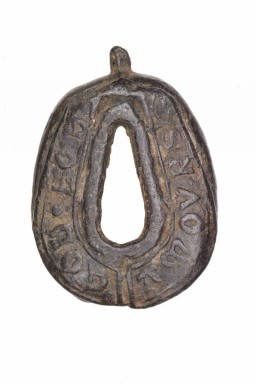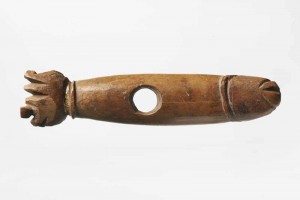Exhibitions | Archeological Erotica at Museum of London
by Victoria RowleyTwo very well-informed volunteers guide our tour group through the excavation maze, all of its treasures found on UK terrain. As we reach our first table, there is a very mischievous looking foam-lined box. My keen eyes are not disappointed, as a 16th century penis drinking cup emerges from the box. This charming average-sized object is a novelty item, made in ceramic. There is a lack of detail on the object which emphasises its crude character, so one can assume this was made with playful intentions. The group certainly giggles, as it is placed back into the penis and balls shape foam-home.
We quickly regain ourselves after moving to a few Medieval items that seem less extravagant in comparison. The first object is a small open pendant, made of cheap metal possibly lead, with an inscription in french meaning, ‘cunt of love’. The inscription is so small we have to see this through a magnifying glass to make out the words. I can only imagine how thrilled the excavator was upon finding it.
In complete contrast, follows a tiny gold ring belonging to a nun. This is also inscribed, around the outside with words of Godly love, ‘You are my only love’ translated from french.

On the Roman table we have several unique objects, mainly phallic. A few that catch my eye are to my liking. One of them, a suspiciously shaped woman’s hair pin, and also a double-ended Roman fist and phallus pendant in bone. The phallic element in this hair pin is subtle, with rounded testicles forming the tip as a decorative element.
Alongside these objects, is another Roman relic. A small mould-made goddess Venus, which is very dainty and comes in two parts. She is nude, and as she is an immortal goddess she could be depicted nude and still exude serenity, and hold her untouchable status. This one in particular would have been positioned in a household shrine. The self-controlled Roman would have appreciated her aesthetic rather than obtaining enjoyment.
We are greeted by Glynn Davis who is the archeology collections manager at the archives, and he enthusiastically directs us to the glass and ceramics store for the grande finale.
We see the erotic tiles of the Ye Olde Cheshire Cheese pub in Fleet Street. The Plaster of Paris made tiles seem very fragile and delicate, however on closer inspection we recognise that these are no ordinary decor. We can see scenes of frolicking from all angles, women with men, women with women, also using prosthetic limbs and contraptions. Tiles like these would have been readily available to see around gentleman’s clubs and brothels during the mid 18th century. Unfortunately these were rejected for public viewing at the Museum of London, but their risqué flavour and ‘pornographic’ nature is highly appreciated by the tour group.
The prominent theme running through this tour is of seeing the erotic in relation to culture. We can recognise an erotic power/status shift, which is made more dramatic the further we look back. Reality had become ultra-reality to the Romans as the female body is depicted nude in Classical sculpture. Only the goddess Venus would regularly be seen nude in the art and get away with it due to her divinity
Regardless of the Roman phallic symbol’s meaning, more simple objects and decor of the time such as bath tiles, and vases depicting erotic scenes, were intended to evoke both joy and erotic pleasure. We can see this continues into the 18th century with erotic tiles as modern decor.
By seeing these objects I hope we can think more clearly about what we now see as erotic, and how that has been shaped by our culture.
The changing significance of the phallus will continue to interest me greatly because of its history, and Roman iconic depictions. In our contemporary western culture, the female nude has been uncovered and displayed as a power symbol, and the phallus has been charged up with a great erotic significance.
I wonder what we will see when our erotic reality progresses from what we now call pornographic?
If you are interested in paying the Archeological Archive a visit, the Archeological Erotica tours take place for two days only in February every year. The archive is otherwise open to all to by appointment. For more info please visit: http://www.museumoflondon.org.uk/collections-research/laarc/contact-us/
Follow Victoria Rowley on instagram @victoriarowr


